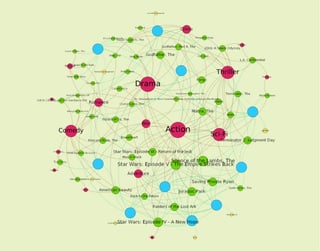The document discusses the Gremlin graph traversal language and its application to the MovieLens dataset, which consists of user ratings for movies. It outlines how to create and manipulate a TinkerGraph, including loading the dataset, counting vertices and edges, and performing various queries to analyze user and movie data. Key insights include the average rating for movies and the categorization of films by genre.
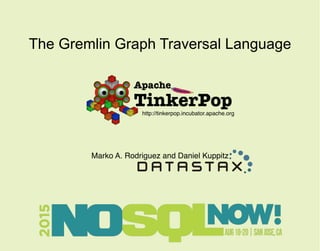
![user movie categoryoccupation
occupation rated category
name:String
gender:[M,F]
age:integer
name:String
year:integer
name:String
stars:[1,2,3,4,5]
http://grouplens.org/datasets/movielens/
MovieLens Dataset](https://image.slidesharecdn.com/nosql-now-2015-150819035929-lva1-app6891/85/The-Gremlin-Graph-Traversal-Language-2-320.jpg)
![user
|Vuser| = 6040
|Vmovie| = 3883
movie
|Vcategory| = 18
category
|Voccupation| = 21
occupation
occupation
|Eoccupation| = 6040
rated
|Erated| = 1000209
category
|Ecategory| = 6408
name:String
gender:[M,F]
age:integer
name:String
year:integer
name:String
stars:[1,2,3,4,5]
http://grouplens.org/datasets/movielens/
G = (V, E)
MovieLens Dataset](https://image.slidesharecdn.com/nosql-now-2015-150819035929-lva1-app6891/85/The-Gremlin-Graph-Traversal-Language-3-320.jpg)

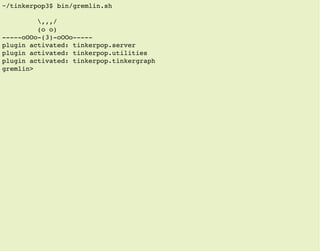

![~/tinkerpop3$ bin/gremlin.sh
,,,/
(o o)
-----oOOo-(3)-oOOo-----
plugin activated: tinkerpop.server
plugin activated: tinkerpop.utilities
plugin activated: tinkerpop.tinkergraph
gremlin> graph = TinkerGraph.open()
==>tinkergraph[vertices:0 edges:0]
gremlin>
"Create a new TinkerGraph."](https://image.slidesharecdn.com/nosql-now-2015-150819035929-lva1-app6891/85/The-Gremlin-Graph-Traversal-Language-7-320.jpg)
![~/tinkerpop3$ bin/gremlin.sh
,,,/
(o o)
-----oOOo-(3)-oOOo-----
plugin activated: tinkerpop.server
plugin activated: tinkerpop.utilities
plugin activated: tinkerpop.tinkergraph
gremlin> graph = TinkerGraph.open()
==>tinkergraph[vertices:0 edges:0]
gremlin>
"Create a new TinkerGraph."
G = (V = ∅, E = ∅)
G The graph is a set of vertices and edges
V The set of vertices in the graph
E The set of edges in the graph
∅ The empty set -- no elements](https://image.slidesharecdn.com/nosql-now-2015-150819035929-lva1-app6891/85/The-Gremlin-Graph-Traversal-Language-8-320.jpg)
![~/tinkerpop3$ bin/gremlin.sh
,,,/
(o o)
-----oOOo-(3)-oOOo-----
plugin activated: tinkerpop.server
plugin activated: tinkerpop.utilities
plugin activated: tinkerpop.tinkergraph
gremlin> graph = TinkerGraph.open()
==>tinkergraph[vertices:0 edges:0]
gremlin>
"Create a new TinkerGraph."
G = (V = ∅, E = ∅)
TitanGraph.open(…)
Neo4jGraph.open(…)
OrientGraph.open(…)
SqlgGraph.open(…)
HadoopGraph.open(…)
GiraphGraphComputer
SparkGraphComputer
ElasticGraph.open(…)
...](https://image.slidesharecdn.com/nosql-now-2015-150819035929-lva1-app6891/85/The-Gremlin-Graph-Traversal-Language-9-320.jpg)
![G = (V = ∅, E ⊆ (V × V ))
~/tinkerpop3$ bin/gremlin.sh
,,,/
(o o)
-----oOOo-(3)-oOOo-----
plugin activated: tinkerpop.server
plugin activated: tinkerpop.utilities
plugin activated: tinkerpop.tinkergraph
gremlin> graph = TinkerGraph.open()
==>tinkergraph[vertices:0 edges:0]
gremlin> graph.io(gryo()).readGraph('/tmp/movie-lens.kryo')
==>null
gremlin>
"Load the MovieLens dataset into the newly created TinkerGraph."
Set A is a subset of (or equal to) set B
The set of all ordered pairs of vertices (directed binary edges)
A ⊆ B
(V × V )](https://image.slidesharecdn.com/nosql-now-2015-150819035929-lva1-app6891/85/The-Gremlin-Graph-Traversal-Language-10-320.jpg)
![~/tinkerpop3$ bin/gremlin.sh
,,,/
(o o)
-----oOOo-(3)-oOOo-----
plugin activated: tinkerpop.server
plugin activated: tinkerpop.utilities
plugin activated: tinkerpop.tinkergraph
gremlin> graph = TinkerGraph.open()
==>tinkergraph[vertices:0 edges:0]
gremlin> graph.io(gryo()).readGraph('/tmp/movie-lens.kryo')
==>null
gremlin> g = graph.traversal()
==>graphtraversalsource[tinkergraph[vertices:9962 edges:1012657], standard]
gremlin>
"Create a graph traversal source for spawning graph traversals over the MovieLens graph."](https://image.slidesharecdn.com/nosql-now-2015-150819035929-lva1-app6891/85/The-Gremlin-Graph-Traversal-Language-11-320.jpg)
![~/tinkerpop3$ bin/gremlin.sh
,,,/
(o o)
-----oOOo-(3)-oOOo-----
plugin activated: tinkerpop.server
plugin activated: tinkerpop.utilities
plugin activated: tinkerpop.tinkergraph
gremlin> graph = TinkerGraph.open()
==>tinkergraph[vertices:0 edges:0]
gremlin> graph.io(gryo()).readGraph('/tmp/movie-lens.kryo')
==>null
gremlin> g = graph.traversal()
==>graphtraversalsource[tinkergraph[vertices:9962 edges:1012657], standard]
gremlin> g.V().count()
==>9962
gremlin>
"Count the number of vertices in the graph."
|V | = 9962](https://image.slidesharecdn.com/nosql-now-2015-150819035929-lva1-app6891/85/The-Gremlin-Graph-Traversal-Language-12-320.jpg)
![~/tinkerpop3$ bin/gremlin.sh
,,,/
(o o)
-----oOOo-(3)-oOOo-----
plugin activated: tinkerpop.server
plugin activated: tinkerpop.utilities
plugin activated: tinkerpop.tinkergraph
gremlin> graph = TinkerGraph.open()
==>tinkergraph[vertices:0 edges:0]
gremlin> graph.io(gryo()).readGraph('/tmp/movie-lens.kryo')
==>null
gremlin> g = graph.traversal()
==>graphtraversalsource[tinkergraph[vertices:9962 edges:1012657], standard]
gremlin> g.V().count()
==>9962
gremlin>
"Count the number of vertices in the graph."
|V | = 9962
Vertex
map 9962
reducing barrier
Long
seed=0
value=seed
binary operator: value -> value+1
count()
{ "m
any-to-one"](https://image.slidesharecdn.com/nosql-now-2015-150819035929-lva1-app6891/85/The-Gremlin-Graph-Traversal-Language-13-320.jpg)
![Edge
map 1012657
reducing barrier
Long
|E| = 1012657
~/tinkerpop3$ bin/gremlin.sh
,,,/
(o o)
-----oOOo-(3)-oOOo-----
plugin activated: tinkerpop.server
plugin activated: tinkerpop.utilities
plugin activated: tinkerpop.tinkergraph
gremlin> graph = TinkerGraph.open()
==>tinkergraph[vertices:0 edges:0]
gremlin> graph.io(gryo()).readGraph('/tmp/movie-lens.kryo')
==>null
gremlin> g = graph.traversal()
==>graphtraversalsource[tinkergraph[vertices:9962 edges:1012657], standard]
gremlin> g.V().count()
==>9962
gremlin> g.E().count()
==>1012657
gremlin>
"Count the number of edges in the graph."
count()
{ "m
any-to-one"](https://image.slidesharecdn.com/nosql-now-2015-150819035929-lva1-app6891/85/The-Gremlin-Graph-Traversal-Language-14-320.jpg)
![~/tinkerpop3$ bin/gremlin.sh
,,,/
(o o)
-----oOOo-(3)-oOOo-----
plugin activated: tinkerpop.server
plugin activated: tinkerpop.utilities
plugin activated: tinkerpop.tinkergraph
gremlin> graph = TinkerGraph.open()
==>tinkergraph[vertices:0 edges:0]
gremlin> graph.io(gryo()).readGraph('/tmp/movie-lens.kryo')
==>null
gremlin> g = graph.traversal()
==>graphtraversalsource[tinkergraph[vertices:9962 edges:1012657], standard]
gremlin> g.V().count()
==>9962
gremlin> g.E().count()
==>1012657
gremlin> g.V().label().groupCount()
==>[occupation:21, movie:3883, category:18, user:6040]
gremlin>
"For each vertex in the graph, emit its label, then group and count each distinct label."
user
user
movie
category
...
Vertex String Map<String,Long>
user
user
movie
category
map map
reducing
barrier
[
occupation=21,
movie=3883,
category=18,
user=6040
]
label() groupCount(){"one-to-one" "many-to-one"](https://image.slidesharecdn.com/nosql-now-2015-150819035929-lva1-app6891/85/The-Gremlin-Graph-Traversal-Language-15-320.jpg)
![~/tinkerpop3$ bin/gremlin.sh
,,,/
(o o)
-----oOOo-(3)-oOOo-----
plugin activated: tinkerpop.server
plugin activated: tinkerpop.utilities
plugin activated: tinkerpop.tinkergraph
gremlin> graph = TinkerGraph.open()
==>tinkergraph[vertices:0 edges:0]
gremlin> graph.io(gryo()).readGraph('/tmp/movie-lens.kryo')
==>null
gremlin> g = graph.traversal()
==>graphtraversalsource[tinkergraph[vertices:9962 edges:1012657], standard]
gremlin> g.V().count()
==>9962
gremlin> g.E().count()
==>1012657
gremlin> g.V().label().groupCount()
==>[occupation:21, movie:3883, category:18, user:6040]
gremlin> g.E().hasLabel('rated').values('stars').mean()
==>3.581564453029317
gremlin>
"For each rated-edge in the graph, emit its stars property value and compute the average value."](https://image.slidesharecdn.com/nosql-now-2015-150819035929-lva1-app6891/85/The-Gremlin-Graph-Traversal-Language-16-320.jpg)
![~/tinkerpop3$ bin/gremlin.sh
,,,/
(o o)
-----oOOo-(3)-oOOo-----
plugin activated: tinkerpop.server
plugin activated: tinkerpop.utilities
plugin activated: tinkerpop.tinkergraph
gremlin> graph = TinkerGraph.open()
==>tinkergraph[vertices:0 edges:0]
gremlin> graph.io(gryo()).readGraph('/tmp/movie-lens.kryo')
==>null
gremlin> g = graph.traversal()
==>graphtraversalsource[tinkergraph[vertices:9962 edges:1012657], standard]
gremlin> g.V().count()
==>9962
gremlin> g.E().count()
==>1012657
gremlin> g.V().label().groupCount()
==>[occupation:21, movie:3883, category:18, user:6040]
gremlin> g.E().hasLabel('rated').values('stars').mean()
==>3.581564453029317
gremlin> g.V().hasLabel('user').map(outE('rated').count()).max()
==>2314
gremlin>
"What is the maximum number of movies a single user rated?"](https://image.slidesharecdn.com/nosql-now-2015-150819035929-lva1-app6891/85/The-Gremlin-Graph-Traversal-Language-17-320.jpg)
![~/tinkerpop3$ bin/gremlin.sh
,,,/
(o o)
-----oOOo-(3)-oOOo-----
plugin activated: tinkerpop.server
plugin activated: tinkerpop.utilities
plugin activated: tinkerpop.tinkergraph
gremlin> graph = TinkerGraph.open()
==>tinkergraph[vertices:0 edges:0]
gremlin> graph.io(gryo()).readGraph('/tmp/movie-lens.kryo')
==>null
gremlin> g = graph.traversal()
==>graphtraversalsource[tinkergraph[vertices:9962 edges:1012657], standard]
gremlin> g.V().count()
==>9962
gremlin> g.E().count()
==>1012657
gremlin> g.V().label().groupCount()
==>[occupation:21, movie:3883, category:18, user:6040]
gremlin> g.E().hasLabel('rated').values('stars').mean()
==>3.581564453029317
gremlin> g.V().hasLabel('user').map(outE('rated').count()).max()
==>2314
gremlin> g.V().hasLabel('movie').values('year').min()
==>1919
gremlin>
"What year was the oldest movie made?"](https://image.slidesharecdn.com/nosql-now-2015-150819035929-lva1-app6891/85/The-Gremlin-Graph-Traversal-Language-18-320.jpg)
![gremlin> g.V().hasLabel('category').values('name')
==>Animation
==>Children's
==>Comedy
==>Adventure
==>Fantasy
==>Romance
==>Drama
==>Action
==>Crime
==>Thriller
==>Horror
==>Sci-Fi
==>Documentary
==>War
==>Musical
==>Mystery
==>Film-Noir
==>Western
"For each vertex that is labeled 'category,' emit the name property value of that vertex."
category
user
user
movie
category
Vertex
category
category
category
category
category
categorycategory
category
Vertex
Animation
Children's
Comedy
Adventure
Western
...
String
filter map
hasLabel('category') values('name')
"one-to-[one-or-none]" "one-to-one"](https://image.slidesharecdn.com/nosql-now-2015-150819035929-lva1-app6891/85/The-Gremlin-Graph-Traversal-Language-19-320.jpg)
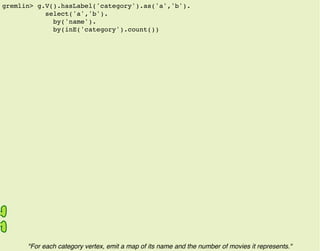

![gremlin> g.V().hasLabel('category').as('a','b').
select('a','b').
by('name').
by(inE('category').count())
==>[a:Animation, b:105]
==>[a:Children's, b:251]
==>[a:Comedy, b:1200]
==>[a:Adventure, b:283]
==>[a:Fantasy, b:68]
==>[a:Romance, b:471]
==>[a:Drama, b:1603]
==>[a:Action, b:503]
==>[a:Crime, b:211]
==>[a:Thriller, b:492]
==>[a:Horror, b:343]
==>[a:Sci-Fi, b:276]
==>[a:Documentary, b:127]
==>[a:War, b:143]
==>[a:Musical, b:114]
==>[a:Mystery, b:106]
==>[a:Film-Noir, b:44]
==>[a:Western, b:68]
"For each category vertex, emit a map of its name and the number of movies it represents."
category
user
user
movie
category
Vertex
category
category
category
category
category
categorycategory
category
Vertex
[a:Animation, b:105]
[a:Children's, b:251]
[a:Comedy, b:1200]
[a:Adventure, b:283]
…
[a:Western, b:68]
Map<String,Long>
filter map
category
name:Animation
category
category
category
...
category
map map
reducing
barrier
105
Vertex Edge Long
category
name:Animation
Vertex String
map Animationa
b
map
flatMap
{"one-to-m
any"
"one-to-one"](https://image.slidesharecdn.com/nosql-now-2015-150819035929-lva1-app6891/85/The-Gremlin-Graph-Traversal-Language-22-320.jpg)

![gremlin> g.V().hasLabel('movie').as('a','b').
select('a','b').
by('name').
by(inE('rated').values('stars').mean()).
order().by(select('b'),decr).
limit(10)
==>[a:Charm's Incidents, b:NaN]
==>[a:Prerokbe Ognja, b:NaN]
==>[a:Leopard Son, The, b:NaN]
==>[a:Bird of Prey, b:NaN]
==>[a:Plutonium Circus, b:NaN]
==>[a:Hustler White, b:NaN]
==>[a:Curtis's Charm, b:NaN]
==>[a:Three Lives and Only One Death, b:NaN]
==>[a:Hoogste tijd, b:NaN]
==>[a:Entertaining Angels: The Dorothy Day Story, b:NaN]
category
user
user
movie
category
Vertex
movie
movie
movie
movie
movie
moviemovie
movie
Vertex
[a:Charm's Incidents, b:NaN]
[a:Prerokbe Ognja, b:NaN]
[a:Leopard Son, The, b:NaN]
[a:Bird of Prey, b:NaN]
...
[a:Entertaining Angels, b:NaN]
Map<String,Double>
filter map
movie
name:Charm's Incidents
map
reducing
barrier
NaN
Vertex Edge Double
movie
name:Charm's Incidents
Vertex String
map Charm's Incidentsa
b
map
map
Integer
...
"For each movie, emit a map of its name and average rating.
Sort the maps in decreasing order by their average rating. Emit the first 10 maps (i.e. top 10)."
flatMap](https://image.slidesharecdn.com/nosql-now-2015-150819035929-lva1-app6891/85/The-Gremlin-Graph-Traversal-Language-24-320.jpg)
![gremlin> g.V().hasLabel('movie').as('a','b').
select('a','b').
by('name').
by(coalesce(
inE('rated').values('stars'),
constant(0)).mean()).
order().by(select('b'),decr).
limit(10)
==>[a:Lured, b:5.0]
==>[a:One Little Indian, b:5.0]
==>[a:Bittersweet Motel, b:5.0]
==>[a:Gate of Heavenly Peace, The, b:5.0]
==>[a:Follow the Bitch, b:5.0]
==>[a:Schlafes Bruder (Brother of Sleep), b:5.0]
==>[a:Ulysses (Ulisse), b:5.0]
==>[a:Song of Freedom, b:5.0]
==>[a:Smashing Time, b:5.0]
==>[a:Baby, The, b:5.0]
"For each movie, get its name and mean rating (or 0 if no ratings). Order by average rating and emit top 10."
user
user
movie
category
Vertex
movie
movie
movie
movie
moviemovie
movie
Vertex Map<String,Double>
filter map
movie
name:Charm's Incidents
map map
reducing
barrier
0.0
Vertex Integer Double
movie
name:Charm's Incidents
Vertex String
map Charm's Incidentsa
b
map
0
[a:Lured, b:5.0]
[a:One Little Indian, b:5.0]
[a:Bittersweet Motel, b:5.0]
[a:Gate of Heavenly Peace, b:5.0]
...
[a:Baby, The, b:5.0]
Map<String,Double>
map
[a:Charm's Incidents, b:NaN]
[a:Prerokbe Ognja, b:NaN]
[a:Leopard Son, The, b:NaN]
[a:Bird of Prey, b:NaN]
...
[a:Entertaining Angels, b:NaN]
collecting
barrier](https://image.slidesharecdn.com/nosql-now-2015-150819035929-lva1-app6891/85/The-Gremlin-Graph-Traversal-Language-25-320.jpg)

![gremlin> g.V().hasLabel('movie').as('a','b').
where(inE('rated').count().is(gt(10))).
select('a','b').
by('name').
by(inE('rated').values('stars').mean()).
order().by(select('b'),decr).
limit(10)
==>[a:Sanjuro, b:4.608695652173913]
==>[a:Seven Samurai (The Magnificent Seven), b:4.560509554140127]
==>[a:Shawshank Redemption, The, b:4.554557700942973]
==>[a:Godfather, The, b:4.524966261808367]
==>[a:Close Shave, A, b:4.52054794520548]
==>[a:Usual Suspects, The, b:4.517106001121705]
==>[a:Schindler's List, b:4.510416666666667]
==>[a:Wrong Trousers, The, b:4.507936507936508]
==>[a:Sunset Blvd. (a.k.a. Sunset Boulevard), b:4.491489361702127]
==>[a:Raiders of the Lost Ark, b:4.47772]
"For each movie with at least 11 ratings, emit a map of its name and average rating.
Sort the maps in decreasing order by their average rating. Emit the first 10 maps (i.e. top 10)."
map
movie
name:Sanjuro
rated
rated
rated
...
rated
map
reducing
barrier
4.60
Vertex Edge Double
movie
name:Sanjuro
Vertex String
map Sanjuroa
b
map
map
Integer
user
user
movie
category
Vertex
movie
movie
movie
movie
moviemovie
movie
Vertex
filter
movie
rated
rated
rated
...
rated
reducing
barrier
Vertex Edge
map
Long
69
name:Sanjuro
filter
movie
movie
movie
movie
movie
Vertex
5
4
…
5
[[a:Sanjuro, b:4.60]
[a:Seven Samurai, b:4.56]
[a:Shawshank Redemption, b:4.55]
[a:Godfather, The, b:4.52]
...
[a:Raiders of the Lost Ark, b:4.47]
[…]
[…]
[…]
[…]
…
[…]
Map<String,Double> Map<String,Double>
map
collecting
barrier
flatMap
flatMap
{
{](https://image.slidesharecdn.com/nosql-now-2015-150819035929-lva1-app6891/85/The-Gremlin-Graph-Traversal-Language-27-320.jpg)
![gremlin> g.V().hasLabel('movie').
where(inE('rated').count().is(gt(10))).
toString()
==>[GraphStep([],vertex), HasStep([~label.eq(movie)]),
TraversalFilterStep([
VertexStep(IN,[rated],edge),
CountGlobalStep,
IsStep(gt(10))])]
"What is the execution plan for the traversal prior to compiler optimizations being applied?"
V : G → V ∗
hasLabelmovie : V ∗
→ V ∗
where : V ∗
→
inErated : V ∗
→ E∗
count : E∗
→ N
isgt(10) : N → (N ∪ ∅)
→ V ∗
"true
orfalse"](https://image.slidesharecdn.com/nosql-now-2015-150819035929-lva1-app6891/85/The-Gremlin-Graph-Traversal-Language-28-320.jpg)
![gremlin> g.V().hasLabel('movie').
where(inE('rated').count().is(gt(10))).
iterate().toString()
==>[TinkerGraphStep(vertex,[~label.eq(movie)]),
TraversalFilterStep([
VertexStep(IN,[rated],edge),
RangeGlobalStep(0,11),
CountGlobalStep,
IsStep(gt(10))])]
"What is the execution plan for the traversal after compiler optimizations have been applied?"
* TinkerGraphStragegy: Access vendor-specific vertex partition by label.
* RangeByIsCountStrategy: Only iterate 1 more than required count.
where : V ∗
→
inErated : V ∗
→ E∗
count : E∗
→ N
isgt(10) : N → (N ∪ ∅)
limit11 : E∗
→ E∗
Vlabel=movie : G → V ∗
→ V ∗
"true
orfalse"](https://image.slidesharecdn.com/nosql-now-2015-150819035929-lva1-app6891/85/The-Gremlin-Graph-Traversal-Language-29-320.jpg)
![gremlin> g.getStrategies()
==>ConjunctionStrategy
a.and().b => and(a,b)
a.or().b => or(a,b)
a.or().b.and().c => or(a,and(b,c))
a.and().b.or().c => or(and(a,b),c)
==>IncidentToAdjacentStrategy
a.outE().inV().b => a.out().b
==>AdjacentToIncidentStrategy
a.in().count().b => a.inE().count().b
a.where(out()).b => a.where(outE()).b
a.and(in(),out()).b => a.and(inE(),outE()).b
==>IdentityRemovalStrategy
a.identity().b => a.b
==>FilterRankingStrategy
a.order().dedup().b => a.dedup().order().b
a.and(c,d).has().b => a.has().and(c,d).b
a.simplePath().where().b => b.where().simplePath().a
==>MatchPredicateStrategy
a.match(c,d).where(e).b => a.match(c,d,e)
a.match(has(),c,d).b => a.has().match(c,d).b
==>RangeByIsCountStrategy
a.count().is(0) => a.limit(1).count().is(0)
==>TinkerGraphStepStrategy
V.has().has().b => V[has,has].b
==>ProfileStrategy
a.b.c.profile() => a.profile().b.profile().c.profile()
==>ComputerVerificationStrategy
a.order.b => IllegalStateException
a.local(out().out()).b => IllegalStateException
"What compilation strategies are associated with the graph traversal source?"](https://image.slidesharecdn.com/nosql-now-2015-150819035929-lva1-app6891/85/The-Gremlin-Graph-Traversal-Language-30-320.jpg)
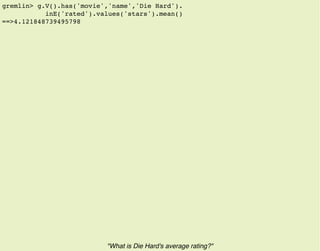
![gremlin> g.V().has('movie','name','Die Hard').
inE('rated').values('stars').mean()
==>4.121848739495798
"What is Die Hard's average rating?"
movie
movie
movie
Vertex
movie
Vertex
filter
name:Die Hard
flatMap
rated
rated
rated
...
rated
Edge
map
3
5
5
…
4
Integer
map
Double
4.1218
reducing
barrier
V : G → V ∗
hasLabelmovie : V ∗
→ V ∗
hasname=Die Hard : V ∗
→ V ∗
inErated : V ∗
→ E∗ mean : N∗
→ R
valuesstars : E∗
→ N∗
user
user
movie
user
Vertex
filter
{
"one-to-[one-or-none]"
"one-to-[one-or-none]"
"one-to-many"
"one-to-one"
"many-to-one"](https://image.slidesharecdn.com/nosql-now-2015-150819035929-lva1-app6891/85/The-Gremlin-Graph-Traversal-Language-32-320.jpg)
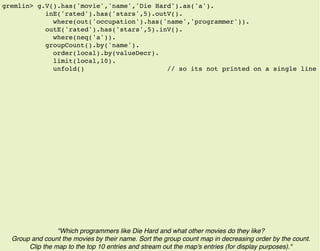
![gremlin> g.V().has('movie','name','Die Hard').as('a').
inE('rated').has('stars',5).outV().
where(out('occupation').has('name','programmer')).
outE('rated').has('stars',5).inV().
where(neq('a')).
groupCount().by('name').
order(local).by(valueDecr).
limit(local,10).
unfold() // so its not printed on a single line
"Which programmers like Die Hard and what other movies do they like?
Group and count the movies by their name. Sort the group count map in decreasing order by the count.
Clip the map to the top 10 entries and stream out the map's entries (for display purposes)."
user
user
movie
user
Vertex
movie
Vertex
filter filter
name:Die Hard
flatMap
rated
rated
rated
...
rated
Edge
filter
rated
...
rated
Edge
map
Vertex
user
user
user
useruser
user
Vertex Vertex
occupationflatMap
Vertex
filter
rated
rated
rated
...
rated
Edge
filter
rated
...
rated
Edge
map
Vertex
movie
movie
moviemovie
movie
Vertex
Vertex
user
user
user
flatMap filter movie
Vertex
filter
Vertex
movie
movie
movie
map
reducing
barrier
[
Aliens=105,
Braveheart=24,
…
Pulp Fiction=19
]
Map<String,Long>
map
collecting
barrier
[
Raider of the Lost Ark=36,
Star Wars: Episode V=24,
Star Wars: Episode IV=34
…
Airplane II: The Sequel=1
]
Map<String,Long>
[
Raider of the Lost Ark=36,
Star Wars: Episode V=24,
Star Wars: Episode IV=34
…
Alien=22
]
Map<String,Long>
map
occupation
programmer
not Die Hard](https://image.slidesharecdn.com/nosql-now-2015-150819035929-lva1-app6891/85/The-Gremlin-Graph-Traversal-Language-34-320.jpg)

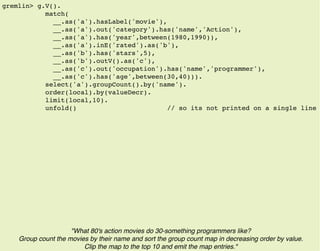
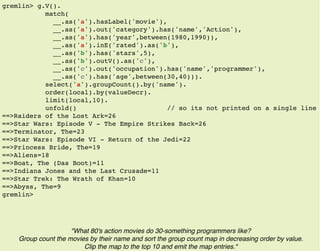

![// CountMatchAlgorithm (default)
gremlin> clockWithResult(50){
g.V().match(
__.as('a').out('rated').as('b'),
__.as('a').out('occupation').has('name','farmer')).
select('a','b').count().next()}
==>66.31955294 // time in milliseconds
==>2706 // number of results
// GreedyMatchAlgorithm
gremlin> g = graph.traversal(GraphTraversalSource.build().
with(MatchAlgorithmStrategy.build().
algorithm(MatchStep.GreedyMatchAlgorithm).create()))
==>graphtraversalsource[tinkergraph[vertices:9962 edges:1012657], standard]
gremlin> clockWithResult(50){
g.V().match(
__.as('a').out('rated').as('b'),
__.as('a').out('occupation').has('name','farmer')).
select('a','b').count().next()}
==>1902.6290871599997 // time in milliseconds
==>2706 // number of results
"Which movies did each farmer rate? -- benchmark CountMatchAlgorithm vs. GreedyMatchAlgorithm."
farmermoviesusers
1000209 2706
farmer moviesusers
17 2706](https://image.slidesharecdn.com/nosql-now-2015-150819035929-lva1-app6891/85/The-Gremlin-Graph-Traversal-Language-39-320.jpg)


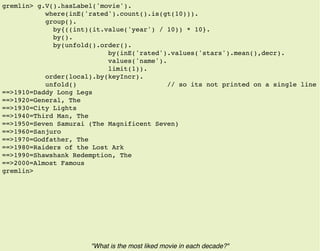
![gremlin> graph = HadoopGraph.open('conf/hadoop/movie-lens.properties')
==>hadoopgraph[gryoinputformat->gryooutputformat]
gremlin> g = graph.traversal(computer(SparkGraphComputer))
==>graphtraversalsource
[hadoopgraph[gryoinputformat->gryooutputformat], sparkgraphcomputer]
gremlin>
"Which movies are most central in the implicit 5-stars graph?"](https://image.slidesharecdn.com/nosql-now-2015-150819035929-lva1-app6891/85/The-Gremlin-Graph-Traversal-Language-43-320.jpg)
![gremlin> graph = HadoopGraph.open('conf/hadoop/movie-lens.properties')
==>hadoopgraph[gryoinputformat->gryooutputformat]
gremlin> g = graph.traversal(computer(SparkGraphComputer))
==>graphtraversalsource
[hadoopgraph[gryoinputformat->gryooutputformat], sparkgraphcomputer]
gremlin> g.V().repeat(outE('rated').has('stars', 5).inV().
groupCount('m').by('name').
inE('rated').has('stars', 5).outV()).
times(4).cap('m')
"Which movies are most central in the implicit 5-stars graph?"
user movie user
ratedrated
m
4x
cap('m')
repeat(…).times(4)
g.V()
stars=5 stars=5](https://image.slidesharecdn.com/nosql-now-2015-150819035929-lva1-app6891/85/The-Gremlin-Graph-Traversal-Language-44-320.jpg)
![gremlin> graph = HadoopGraph.open('conf/hadoop/movie-lens.properties')
==>hadoopgraph[gryoinputformat->gryooutputformat]
gremlin> g = graph.traversal(computer(SparkGraphComputer))
==>graphtraversalsource
[hadoopgraph[gryoinputformat->gryooutputformat], sparkgraphcomputer]
gremlin> g.V().repeat(outE('rated').has('stars', 5).inV().
groupCount('m').by('name').
inE('rated').has('stars', 5).outV()).
times(4).cap('m')
==>Fantasia 2000=2676505178171564
==>Pale Rider=1369969000295362
==>Crucible, The=401712993698149
==>About Adam=37981148456999
==>Akira=3659939409345918
...
gremlin>
"Which movies are most central in the implicit 5-stars graph?"](https://image.slidesharecdn.com/nosql-now-2015-150819035929-lva1-app6891/85/The-Gremlin-Graph-Traversal-Language-45-320.jpg)
![gremlin> graph = HadoopGraph.open('conf/hadoop/movie-lens.properties')
==>hadoopgraph[gryoinputformat->gryooutputformat]
gremlin> g = graph.traversal(computer(SparkGraphComputer))
==>graphtraversalsource
[hadoopgraph[gryoinputformat->gryooutputformat], sparkgraphcomputer]
gremlin> g.V().repeat(outE('rated').has('stars', 5).inV().
groupCount('m').by('name').
inE('rated').has('stars', 5).outV()).
times(4).cap('m')
==>Fantasia 2000=2676505178171564
==>Pale Rider=1369969000295362
==>Crucible, The=401712993698149
==>About Adam=37981148456999
==>Akira=3659939409345918
...
gremlin> hdfs.ls('output/m')
==>rw-r--r-- daniel supergroup 0 _SUCCESS
==>rw-r--r-- daniel supergroup 245314 part-r-00000
gremlin> hdfs.head('output/m', ObjectWritable).sort {-it.value}.take(10)
==>Star Wars: Episode IV - A New Hope 35405394353105332
==>American Beauty 31943228282020585
==>Raiders of the Lost Ark 31224779793238499
==>Star Wars: Episode V - The Empire Strikes Back 30434677119726223
==>Godfather, The 30258518523013057
==>Shawshank Redemption, The 28297717387901031
==>Schindler's List 27539336654199309
==>Silence of the Lambs, The 26736276376806173
==>Fargo 26531050311325270
==>Matrix, The 26395118239203191
"Which movies are most central in the implicit 5-stars graph?"](https://image.slidesharecdn.com/nosql-now-2015-150819035929-lva1-app6891/85/The-Gremlin-Graph-Traversal-Language-46-320.jpg)
![gremlin> :plugin use tinkerpop.gephi
==>tinkerpop.gephi activated
gremlin> :remote connect tinkerpop.gephi
==>Connection to Gephi - http://localhost:8080/workspace0 with stepDelay:1000,
startRGBColor:[0.0, 1.0, 0.5], colorToFade:g, colorFadeRate:0.7, startSize:
20.0,sizeDecrementRate:0.33
gremlin>](https://image.slidesharecdn.com/nosql-now-2015-150819035929-lva1-app6891/85/The-Gremlin-Graph-Traversal-Language-47-320.jpg)
![gremlin> :plugin use tinkerpop.gephi
==>tinkerpop.gephi activated
gremlin> :remote connect tinkerpop.gephi
==>Connection to Gephi - http://localhost:8080/workspace0 with stepDelay:1000,
startRGBColor:[0.0, 1.0, 0.5], colorToFade:g, colorFadeRate:0.7, startSize:
20.0,sizeDecrementRate:0.33
gremlin> :> g.V().hasLabel('user').
order().
by(outE('rated').count(), decr).limit(10).as('a').
local(outE('rated').order().
by('stars', decr). // first by stars
by(inV().inE('rated').count(), decr). // then by ratings
limit(10)).
subgraph('sg').inV().outE('category').
subgraph('sg').select('a').outE('occupation').
subgraph('sg').cap('sg').next()
==>tinkergraph[vertices:82 edges:233]
gremlin>
"Which users rated the most movies?
For each user, display their 10 favorite movies, the categories of those movies, and their occupation.
"moviebuffs"](https://image.slidesharecdn.com/nosql-now-2015-150819035929-lva1-app6891/85/The-Gremlin-Graph-Traversal-Language-48-320.jpg)
